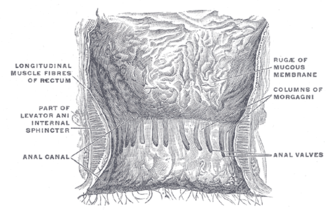| Anal valves | |
|---|---|
 The interior of the anal cami and lower part of the rectum, showing the anal columns and the anal valves between their lower ends (the columns were more numerous in the specimen than usual) | |
| Details | |
| Identifiers | |
| Latin | valvulae anales |
| TA98 | A05.7.05.005 |
| TA2 | 3014 |
| FMA | 74028 |
| Anatomical terminology | |
An anal valve is a small horizontal fold uniting the inferior ends of any two adjacent anal columns of the anal canal. An anal valve forms the inferior boundary of an anal sinus. The anal valves demarcate the level of the pectinate line. [1]